#spectator magazine
Text
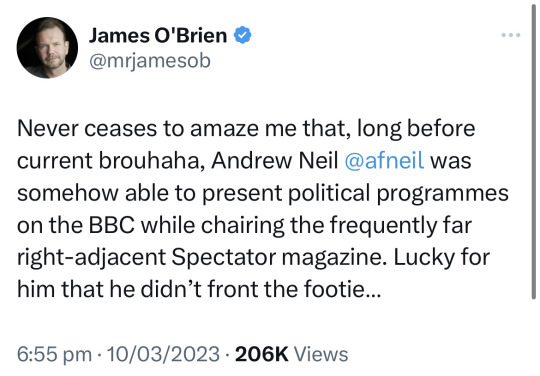
#james o’brien#political twitter#andrew neil#bbc#british broadcasting corporation#spectator magazine#gary lineker#motd
7 notes
·
View notes
Text
Subscribe now The Spectator Magazine Subscriptions Available in India
View all The Spectator magazine's skilled stories and ideas. Get a subscription for complete ideas at Magazinesubscriptions.in right now.

0 notes
Text
Long-lived poetry mags: Spectator, Dreamcatcher, The Journal
I’m delighted to have poems out in three magazines which have proved to have real staying power. Granddaddy of them all is The Spectator (continuously published since 1828). Feisty York-based Dreamcatcher has been wowing its readership with poems, art and short stories for 28 years, and The Journal (formerly Contemporary Anglo-Scandinavian Poetry) has just celebrated an impressive 30 years in…

View On WordPress
#Berthold Brecht#Claire Booker#contemporary poems#Dream Catcher#Emperor Akbar#Hannah Stone#Hugo Williams#literary magazines#new poetry#Princess Gulbadan#Richard Moulton#Sam Smith#short stories#The Journal#The Spectator
0 notes
Text

"Three. Cagliari, Italy, 2012" From The Series "Spectators"
By Nicola Fioravanti
All About Photo Magazine Awards 2023: “Shadows”
#nicola fioravanti#photographer#three cagliari italy 2021#photo series#spectators#all about photo magazine awards 2023: shadows#shadows
0 notes
Text
Susan McLean, 'Morbid Interest'
How unpleasant to meet Mr. Poe. It gives a young lady a chill when, just as she’s saying hello, he asks if she’s lately been ill. It was mid-afternoon, yet he seemed to be tipsy or mildly sedated. How oddly his mournful eyes gleamed when he heard that we might be related. He muttered some rhymes for my name, saying nothing could be more inspiring to a poet desirous of fame than the sight of young…
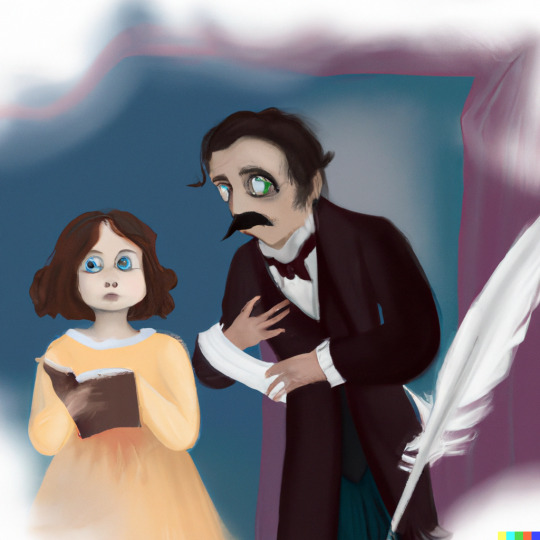
View On WordPress
#DALL-E#Edgar Allan Poe#Edward Lear#How pleasant#How unpleasant#Light Magazine#Spectator#Susan McLean
0 notes
Text
The Spectator [19th century British magazine] thought that while Stoker made admirable use of “vampirology,” the story might have been better had it been set in an earlier period. “The up-to-dateness of the book—the phonograph, diaries, typewriters, and so on—hardly fits in with the mediaeval methods which ultimately secure the victory for Count Dracula’s foes.”
On the subject that contemporaries thought that Dracula was too up-to-date for a vampire story.
Needless to say, the reviewer missed the whole point.
#it was perhaps one of the Themes#the marriage of the medieval and the future#dracula daily#dracula#re: dracula#dracula spoilers#dracula daily spoilers
6K notes
·
View notes
Text
Pink is for Boys
"Pink or Blue? Which is intended for boys and which for girls? This question comes from one of our readers this month, and the discussion may be of interest to others. There has been a great diversity of opinion on this subject, but the generally accepted rule is pink for the boy and blue for the girl. The reason is that pink, being a more decided and stronger color, is more suitable for the boy, while blue, which is more delicate and dainty, is prettier for the girl." ~ The Infants' Department, June 1918


[Left: The Blue Boy, oil on canvas, c. 1770, by Thomas Gainsborough.
Right: The Pink Boy, oil on canvas, c. 1782, by Thomas Gainsborough.]
Pink is for girls and blue is for boys. But it hasn't always been this way. Colour coding infants as a way of denoting gender was popular in 20th century America. The problem? Pink and blue? Which is for boys and which is for girls?
In 1927 TIME Magazine asked ten of the "leading stores that sell baby equipment" which colour was for which gender. Four stores responded pink for girls and blue for boys; Macy's (Manhattan), Franklin Simon (Manhattan), Wanamaker's (Philadelphia) and Bullock's (Los Angeles). Five stores responded pink for boys and blue for girls; Best's (Manhattan), Marshall Field's (Chicago), Filene's (Boston), Maison Blanche (New Orleans) and The White House (San Francisco). Curiously Halle's (Cleveland) responded that pink was for both boys and girls.
This debate would continue and it wasn't until mid-20th century that pink for girls and blue for boys became firmly cemented in western culture.
However the idea of colour coding infants dates back to the 19th century. According to La cour de Hollande sous le règne de Louis Bonaparte in 1808 in Holland pink was used to announce the birth of a girl and blue a boy. In March 1856 Peterson's Magazine (Philadelphia, USA) advises that the ribbon on a christening cap should be blue for a boy and pink for a girl. On the 23rd of July 1893 the New York Times writes that for baby clothes it's "pink for a boy and blue for a girl!"

[The Oddie Children, oil on canvas, c. 1789, by William Beechey, via North Carolina Museum of Art.]
During the latter half of the 18th century one of the most popular outfits for young children, regardless of gender, was a white dress with a coloured sash tied around the waist. Pink and blue being the most popular colours, although other colours were worn as well. It would be tempting to assume that the colour of the sash indicated gender but there isn't clear evidence that this was the case. The Oddie Children (above) depicts Sarah, Henry, Catherine, and Jane Oddie. The three girls are all wearing white dresses; two with a blue sash one with a pink sash. We also see Henry Russell (bellow left) wearing a blue sash and Prince William (bellow right) wearing a pink sash.
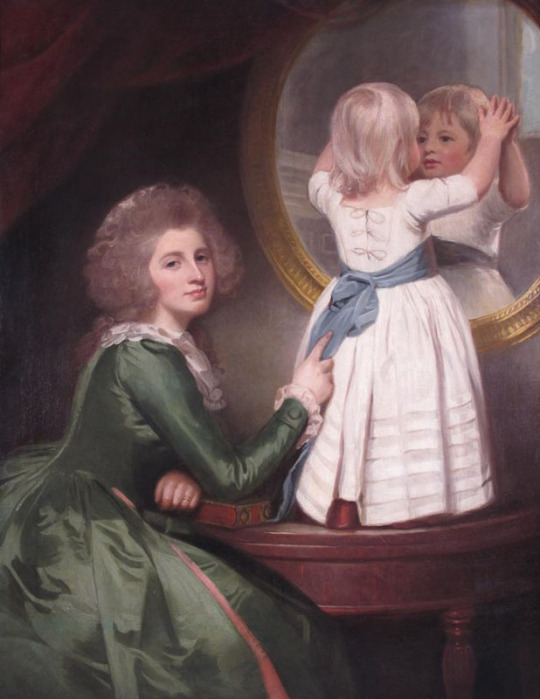
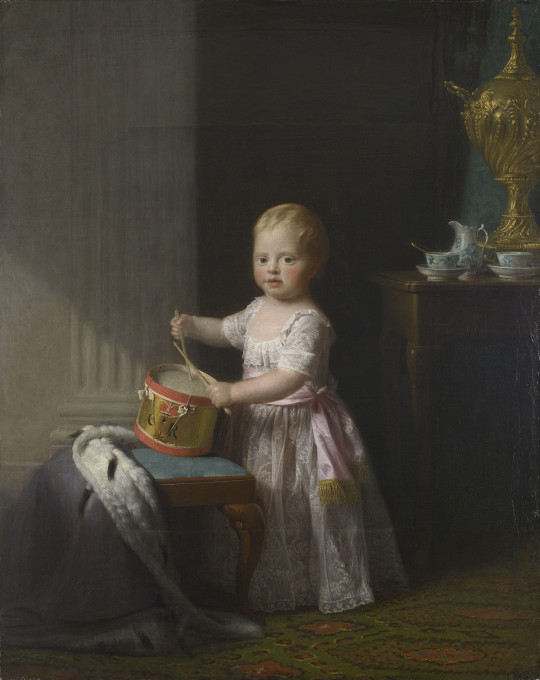
[Left: Anne Barbara Russell née Whitworth with her son Sir Henry Russell, oil on canvas, c. 1786, by George Romney, via Woolley & Wallis.
Right: Prince William, oil on canvas, c. 1767, by Allan Ramsay, via the Royal Collection Trust.]
Pink was just one of the many colours popular in 18th century English womenswear and seems to have stayed popular throughout the century. On the 3rd of January 1712 The Spectator published an article in which a man recalls seeing "a little Cluster of Women sitting together in the prettiest coloured Hoods that I ever saw. One of them was Blew, another Yellow, and another Philomot; the fourth was of a Pink Colour, and the fifth of a pale Green". On the 1st of May 1736 the Read's Weekly Journal, or British Gazetteer reports that the ladies attending the royal wedding wore gowns of "Gold stuffs, or rich Silks with Gold or Silver Flowers, or Pink or White Silks, with either Gold or Silver Netts or Trimmings;" shoes either "Pink, White or Green Silk, with Gold or Silver Lace and braid all over." On the 24th of May 1785 Charles Storer writes to Abigail Adams advising that fashionable colours in English court dress are "pink, lilac, and blue" such "as is worn at Versailles".
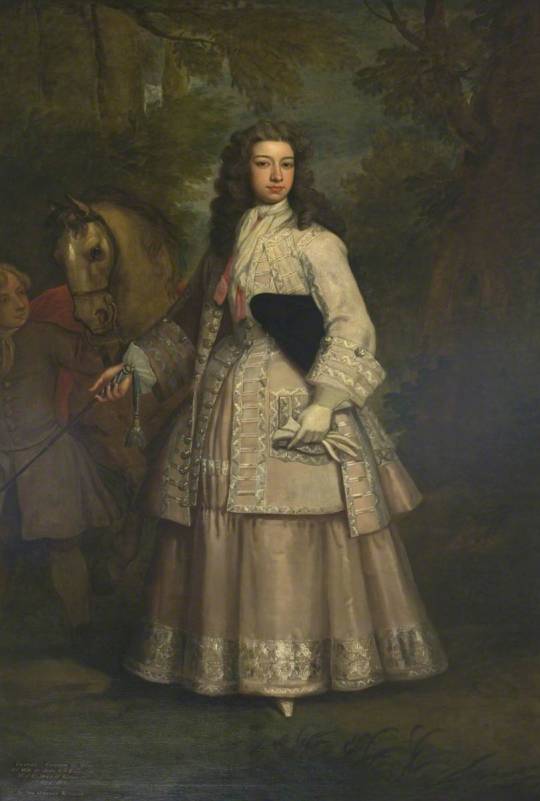
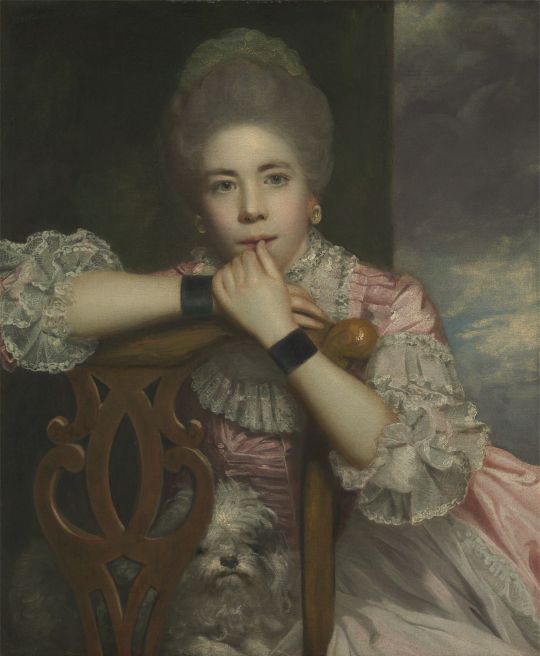
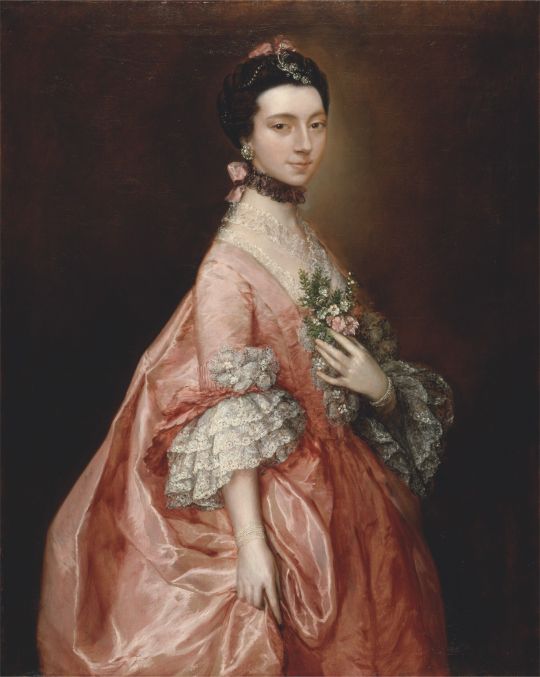
[Left: Frances, Daughter of Evelyn Pierpont, 1st Duke of Kingston, oil on canvas, c. 1700-23, by Godfrey Kneller, via Art UK.
Middle: Mrs. Abington as Miss Prue in "Love for Love" by William Congreve, oil on canvas, c. 1771, by Sir Joshua Reynolds, via Yale Center for British Art.
Right: Mary Little, later Lady Carr, oil on canvas, c. 1765, by Thomas Gainsborough, via Yale Center for British Art.]
In particular pink was popular amongst young women as the colour was associated with youth. Older women who wore pink were mocked as vain for dressing in a way that was seen as improper for their age. On the 31st of January 1754 Lady Jane Coke writes to Mrs. Eyre criticising old women who wear pink:
As for fashions in dress, which you sometimes inquire after, they are too various to describe. One thing is new, which is, there is not such a thing as a decent old woman left, everybody curls their hair, shews their neck, and wears pink, but your humble servant. People who have covered their heads for forty years now leave off their caps and think it becomes them, in short we try to out-do our patterns, the French, in every ridiculous vanity.
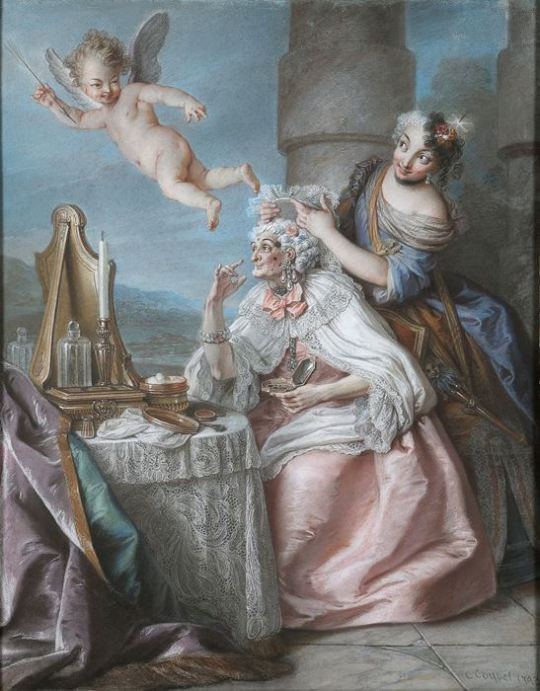
[Folly Embellishing Old Age With the Adornments of Youth, oil on canvas, c. 1743, by Charles-Antoine Coypel, via Master Art.]
For Englishmen acceptable clothing way much more limited. In A Foreign View of England in the Reigns of George I & George II Monsieur César de Saussure writes that Englishmen "do not trouble themselves about dress, but leave that to their womenfolk". He explains:
Englishmen are usually very plainly dressed, they scarcely ever wear gold on their clothes; they wear little coats called "frocks," without facings and without pleats, with a short cape above. Almost all wear small, round wigs, plain hats, and carry canes in their hands, but no swords. Their cloth and linen are of the best and finest. You will see rich merchants and gentlemen thus dressed, and sometimes even noblemen of high rank, especially in the morning, walking through the filthy and muddy streets.
César de Saussure warns that "a well-dressed person in the streets, especially if he is wearing a braided coat, a plume in his hat, or his hair tied in a bow, he will, without doubt, be called "French dog" twenty times perhaps before he reaches his destination" and is not only at risk of "being jeered at" but also "being bespattered with mud, but as likely as not dead dogs and cats will be thrown at him."
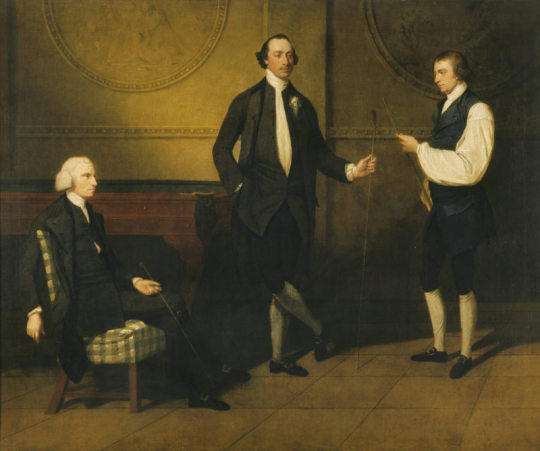
[Reverend Charles Everard Booth, Captain Griffith Booth, and an Unidentified Man playing Billiards, oil on canvas, c. 1775-9, by John Hamilton Mortimer, via the Royal Collection Trust.]
For Englishmen dressing "plainly" mostly meant wearing blacks and browns. In his book on macaroni, Pretty Gentleman, Peter McNeil found that in contrast most English menswear that he describes as generally consisting of "monochrome broadcloth" macaroni wore a variety of colours including green, orange, yellow, violet, red, white, blue, gold, silver and of course pink.
But it's not just the macaroni of the 1770s & 1780s that wore pink. We see pink in descriptions of feminine men's dress (both real and fictional) throughout the 18th century.
On the 2nd of June 1722 Sarah Osborn writes to Robert Byng:
I believe the gentlemen will wear petticoats very soon, for many of their coats were like our mantuas. Lord Essex had a silver tissue coat, and pink color lutestring waistcoat, and several had pink color and pale blue paduasoy coats, which looked prodigiously effeminate.
On the 18th of October 1729 the Universal Spectator and Weekly Journal published a story where an "effeminate" man's clothes were described as follows:
He had a flower'd pink-colour Silk Coat, with a Green-Sattin Waistcoat lac'd with Silver. Velvet Breeches, Clock'd Stockings the Colour of his Coat, Red-heel'd Pumps, a Blue Ribbon at the Collar of his Shirt, and his Sword-Hilt he embrac'd under the Elbow of his Left Arm,

[Sir Miles Stapylton, 4th Bt of Myton, oil on canvas, c. 1730-35, via Art UK.]
In The Adventures of Roderick Random (1748) the effeminate (and queer coded) Captain Whiffle is described as follows:
our new commander came on board in a ten-oared barge, overshadowed with a vast umbrella, and appeared in everything the reverse of Oakum, being a tall, thin young man, dressed in this manner: a white hat, garnished with a red feather, adorned his head, from whence his hair flowed upon his shoulders, in ringlets tied behind with a ribbon. His coat, consisting of pink-coloured silk, lined with white, by the elegance of the cut retired backward, as it were, to discover a white satin waistcoat embroidered with gold, unbuttoned at the upper part to display a brooch set with garnets, that glittered in the breast of his shirt, which was of the finest cambric, edged with right Mechlin: the knees of his crimson velvet breeches scarce descended so low as to meet his silk stockings, which rose without spot or wrinkle on his meagre legs, from shoes of blue Meroquin, studded with diamond buckles that flamed forth rivals to the sun! A steel-hilted sword, inlaid with gold, and decked with a knot of ribbon which fell down in a rich tassel, equipped his side; and an amber-headed cane hung dangling from his wrist. But the most remarkable parts of his furniture were, a mask on his face, and white gloves on his hands, which did not seem to be put on with an intention to be pulled off occasionally, but were fixed with a curious ring on the little finger of each hand.

[Henry Ingram, 7th Viscount Irwin and His Wife Anne, oil on canvas, c. 1745, by Philippe Mercier, via Art UK.]
On the 28th of July 1780 the London Courant reports:
A few days ago, a Macaroni made his appearance in the Assembly-room at Whitehaven, in the Following dress: a mixed silk coat, pink sattin waistcoat and breeches, covered with an elegant silver nett, white silk stockings with pink clocks, pink sattin shoes and large pearl buckles, a mushroom coloured stock, covered with a fine point lace; his hair dressed remarkably high, and stuck full of pearl pins.
On the 6th of August 1792 The Weekly Entertainer published Sketches and Portraits form the Life by Simon Tueopnrastus which included the following description:
Mercator was a youth of some genius and expectation, but by a strange perverseness of disposition, notwithstanding the extreme natural stiffness of his limbs, he had acquired an early attachment to the most finical and effeminate finery; so that, while yet a boy, he would exhaust every expedient of a fertile invention to procure a laced waistcoat, or the most foppish toy; would dangle a watch-string, with brass seals, from each fob, at a time when the frugal care of his parents would not permit him to wear a watch in either; and would strut in a fine pair of second-hand pink silk breeches, and a light blue coat, with all the formal dignity of—a soldier upon the parade.


[Left: Thomas King in "The Clandestine Marriage", oil on canvas, c. 1792, by Samuel De Wilde, via Yale Center for British Art.
Right: Edward Payne, oil on canvas, by Arthur Devis, via Art UK.]
While pink is mentioned in these descriptions of feminine men's dress it's not singled out as the girl colour the way pink would become in the 20th century. I would argue pink is seen as effeminate not because pink is a uniquely feminine colour but because it was used in fashionable dress. In 18th century England being interested in fashion was seen as an frivolous female trait. Men who showed too much interest in fashion were mocked and ridiculed for their gender nonconformity. "A Man must sink below the Dignity of his Nature, before he can suffer his Thoughts to be taken up on so trivial an Affair, as the Chosing, Suiting, and Adjusting the Adornments of his Person," complains a letter published on the 8th of May 1731 in Read's Weekly Journal, or British Gazetteer:
Decency of Garb ought inviolably to be preserved; nor can there be possibly an Excuse for Dressing like a Merry-Andrew: Rich and coloured Silks are in themselves effeminate, and unbecoming a Man; as are, in short, all Things that discover Dress to have been his Study 'Tis in vain for a Fop of Quality, to think his Title will protect him.


[Left: Madame de Pompadour (detail), oil on canvas, c. 1756, by François Boucher, via Alte Pinakothek.
Right: Elizabeth Wrottesley, later Duchess of Grafton, oil on canvas, c. 1764-5, by Thomas Gainsborough, via National Gallery of Victoria.]
English fashion was highly influenced by French fashion. A popular colour scheme in French fashion was green and pink. A famous example of this colour pairing can be seen in François Boucher's portrait of Madame de Pompadour (above left), she is depicted in a green gown with pink bows and flowers. You can see and example of how this style inspired English fashion in Thomas Gainsborough's portrait of Elizabeth Wrottesley (above right), who is depicted in a green gown with a floral pattern adorned with pink, white and green striped bows.
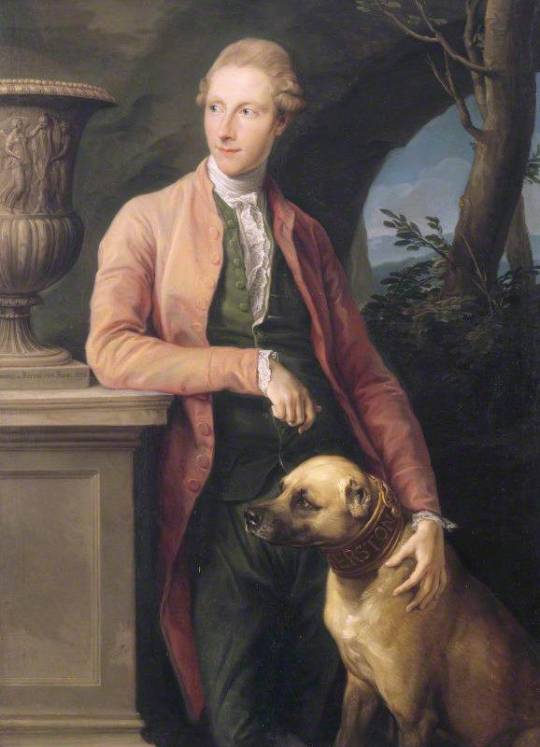
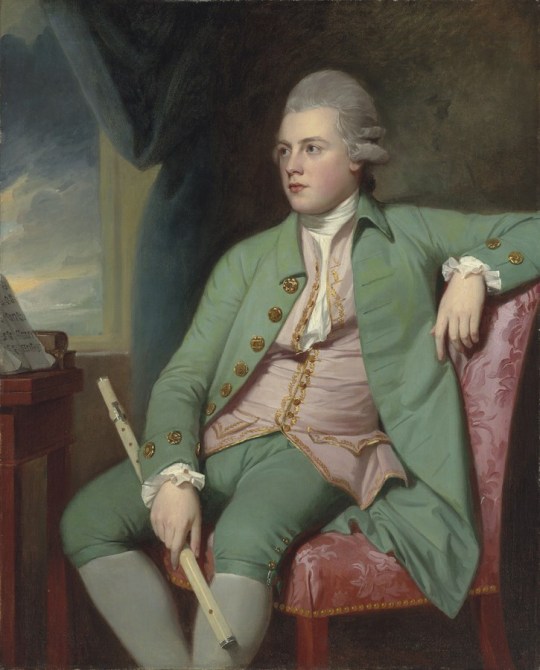
[Left: Sir Harry Fetherstonhaugh, oil on canvas, c. 1776, by Pompeo Batoni, via Wikimedia.
Right: Francis Lind, oil on canvas, c. 1775, by George Romney, via Mackinnon Fine Art.]
Fashionable Englishmen were also inspired by these French designs. Horace Walpole refers to the popularity of the colour combination writing to Lady Ossory on the 19th of February 1774 "If I went to Almack's and decked out my wrinkles in pink and green like Lord Harrington, I might still be in vogue". Almack's is referring to Almack's Assembly Rooms on Pall Mall which is believed to be the inspiration for the Macaroni Club. (see Pretty Gentleman by Petter McNeil p52-55) In a letter to Lord Harcourt on the 27th of July 1773 Walpole writes of "Macaronis lolling out of windows at Almack's like carpets to be dusted."
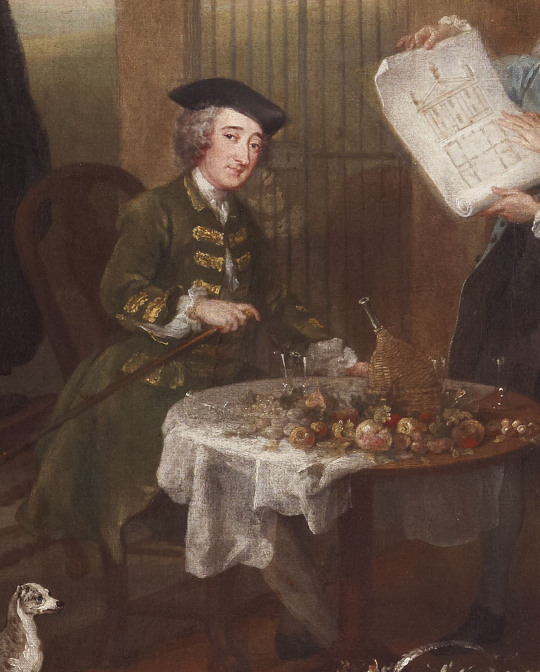

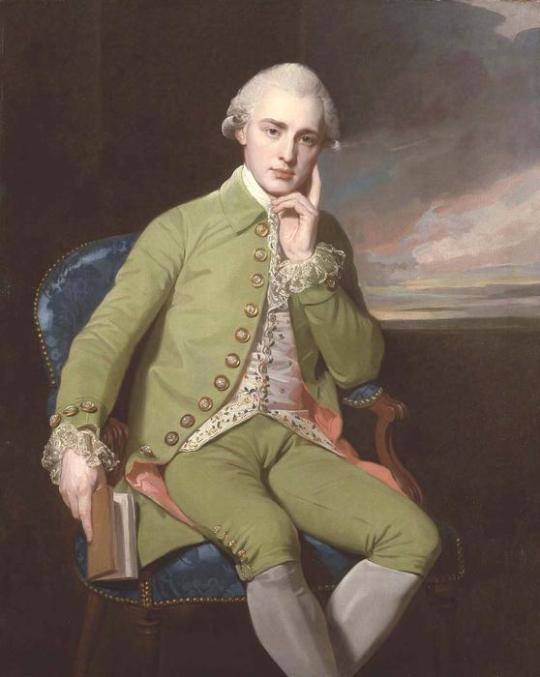
[Left: Detail of Stephen Fox from The Hervey Conversation Piece, oil on canvas, c. 1738-40, by William Hogarth, via Fairfax House.
Middle: Sir William Jones, oil on canvas, c. 1769, by Francis Cotes, via Art UK.
Right: Portrait of a Gentleman, oil on canvas, by George Romney.]
Men who wore green seem to have been just as much, if not more, at risk of being ridiculed, or even assaulted, for the colour of their clothes as those who wore pink. In Pierre Jean Grosley's A Tour to London (originally published 1772) he recalls traveling with a young English surgeon who was harassed by Londoners due to his green French frock coat:
At the first visit which he paid me in London, he informed me, that, a few days after his arrival, happening to take a walk thro' the fields on the Surry side of the Thames, dressed in a little green frock, which he had brought from Paris, he was attacked by three of those gentlemen of the mobility, who, taking him for a Frenchman, not only abused him with the foulest language, but gave him two or three slaps on the face: "Luckily, added he in French, I did not return their ill language; for, if I had, they would certainly have thrown me into the Thames, as they assured me they would, as soon as they perceived I was an Englishman, if I ever happened to come in their way again, in my Paris dress."
230 notes
·
View notes
Text
Lynching victim Rubin Stacy’s story being told by his family in film screening at NSU

Anne Naves knew something bad had happened to her uncle when her male relatives came home from fishing, each wearing a pall of silence. Dad wasn’t cracking jokes like usual. Grandfather looked grave. And her uncle, Rubin Stacy, hadn’t come back. The next day, someone from the funeral home said a body had been dropped off.
Naves, 8 years old at the time, only discovered the full gruesome truth about her uncle years later. On July 19, 1935, acting on an unproven accusation from a white woman, a masked lynch mob strung up Stacy under a Fort Lauderdale tree, hanged him and shot him 17 times as spectators gawked and children laughed.
The brutality and silence of Stacy’s lynching is revisited in the new documentary, “Rubin,” which will screen on Tuesday, Oct. 3, at Nova Southeastern University. In the hourlong film, the farmhand’s death is recounted through the eyes of his surviving descendants, but mainly through Naves, who was the last living eyewitness to the trauma — and to the secrecy — that followed.
The film, the first to be made by relatives of Stacy’s family, also chronicles the history of lynchings in America, used as a tool of punishment and to foster silence.
“I think (my family) knew that, without telling us (kids) what really happened, they would save us a lot of trauma,” Naves says in the documentary. “The neighbors and our church members respected our silence, too, because they knew that if it could happen to our family, it could happen to theirs.”
For “Rubin” director Tenille Brown, who is a cousin of Rubin Stacy, the film has in recent weeks also morphed into something else: a posthumous tribute to Naves. After filming her interviews for the documentary, she died on Sept. 18 at age 96, leaving behind a strong legacy: She was a Broward County educator for 25 years, teaching at Pines Middle and other schools.
“The biggest piece of the film was Anne,” Brown says in an interview with the South Florida Sun Sentinel. “Without her, there’s no story. She’s the driving force. She was ready to talk. She told me to record her. She really pushed me when I didn’t feel confident and said, ‘Record me anyway. Just go.’ ”
The rest of America witnessed the cruelty of Stacy’s lynching long before Naves did. A series of photos immortalize the moment when a white crowd gathered around Stacy’s body hanging from a tree. These images ran in newspapers nationwide, were published by the NAACP, Life magazine and National Geographic, and are now archived in the Library of Congress.
It was a tale of Jim Crow-era racism that Fort Lauderdale would’ve rather forgotten — the brother of a corrupt Broward County sheriff participated in the lynching — but city officials have made strides in recent years to acknowledge the tragedy by placing memorial markers around Fort Lauderdale. One is on Davie Boulevard and Southwest 31st Avenue, also known as Martin Luther King Jr. Avenue, near where Stacy took his last breath. There’s another on the 800 block of Northwest Second Street, where he lived, and a third at Woodlawn Cemetery, his final resting place. In February 2022, a section of Davie Boulevard was renamed Rubin Stacy Memorial Boulevard.
“I’m glad they acknowledged it,” says Brown, of Pompano Beach. “These stories make some people in the state uncomfortable, but if they are based on fact, we need to tell the truth. You can’t turn your head. These are things you can’t ignore.”
For Brown, it was these memorials — and Naves’ willingness to break her silence — that motivated her to reconstruct Stacy’s story. To do so, she also interviewed Ken Cutler, Parkland commissioner and historian, and Tameka Bradley Hobbs, library regional manager of Fort Lauderdale’s African American Research Library and Cultural Center.
“My family didn’t want to talk about it out of fear for years,” Brown says. “There was shame. There’s an element of hurt, and you can hear that emotion in Anne’s voice. Now it feels freeing. This is a story that was suppressed for years and by sharing it, this is how we overcome.”
Michael Anderson, a producer for “Rubin,” says the film also tackles what too many school textbooks don’t stress enough: the history of Black lynchings.
“For Black youth to know their stories, they have to know the history of lynchings,” Anderson says. “They still don’t know how lynchings were used as a weapon to keep a community quiet. That’s exactly what it did to Rubin Stacy’s family.”
IF YOU GO
WHAT: “Rubin”
WHEN: 7 p.m. Tuesday, Oct. 3
WHERE: NSU’s Rose & Alfred Miniaci Performing Arts Center, 3100 Ray Ferrero Jr. Blvd., Davie
COST: Free, but tickets must be presented for entry
INFORMATION: 954-462-0222; MiniaciPAC.com
#https://www.msn.com/en-us/news/other/lynching-victim-rubin-stacy-s-story-being-told-by-his-family-in-film-screening-at-nsu/ar-AA1huFAr#Lynching in america#Black People#Black American Lynchings#Lynching victim Rubin Stacy’s story being told by his family in film screening at NSU
149 notes
·
View notes
Text
Hawkins is the most boring dot on the map Neil could find and now Billy is here. In a town that feels all superior in its tristesse and stiffness, but otherwise everybody lives at least twenty years in the past. A place where wearing a crop top is considered a sin and everybody is so painfully conservative Billy bets his ass that the police swings by to check if people are only fucking in missionary position and are wearing their wedding rings.
Well. Apparently they are fucking in missionary position. But it's not very conservative. Billy closes the door of the bedroom he stumbled in. It's another party from a girl or a guy from High School (or so Billy thinks) and he just wanted to take a break from the noise and pretending.
It doesn't make sense. Tommy hates Steve Harrington, why would he be under him? And worse, why does it make Billy's stomach twist? Maybe because it's gay shit. Billy doesn't do gay shit.
A few days later when the last week of school starts Billy can't look either of them in the eye. He swears Harrington winks at him in the hallway. Billy turns around. During algebra he's sneaking out to smoke on the school's toilet when he hears a loud moan. He rubs his temples. It's Harrington's voice. He recognizes that low timbre. That can't be.
He presses out his cigarette against the tiles. Just the moment Harrington comes out of the stall, pulling up his zipper.
"I thought you were a player not a spectator," he says to Billy. Eyes raking over him. He looks hungry.
"What the fuck is that supposed to mean?" Billy grunts.
Hagan walks out of the stall, combing his hair with his hands. "C'mon, you know what he's saying. You can join us."
"You said Harrington turned bitch." Billy doesn't get Tommy. He just knows he hates the hickey above his collarbone.
"I say a lot of things." Tommy shrugs.
Harrington laughs. Unfazed. His eyes don't leave Billy. "Some people just need to get it out of their system."
Billy doesn't need to work through anything. He jerks off at home, pretending to look at a magazine and at Shauna Grant, but ends off thinking about Harrington's big dick. Billy doesn't do gay shit. Doesn't mean he doesn't think about it.
The next day Harrington leans against his car. Designer clothes and expensive aftershave. Billy crosses his arms.
"What do you want?" he sneers.
"Isn't that obvious?" Harrington asks, raising a brow.
Billy feels like a dessert. Harrington looks like he wants to eat him, he thinks.
"You," Harrington says. "I want you. So are you comin' or what?"
Billy looks over to the BMW. Tommy is already sitting on the backseat, grinning at him.
"I'm not your bitch," he says.
Harrington smiles. "Of course."
Billy just needs to get it out of his system. It's only one time, right?
#he totally is#you know every time i write keg boys it ends with billy fixating on steve - good for him#harringrove#billy x steve#steve x billy#keg boys#harringrove ficlet#billy hargrove
151 notes
·
View notes
Text
In the summer of 2022, when Liz Truss was about to become prime minister, I noticed that she was an admirer of Rick Perlstein, one of the great historians of modern America.
Aspiring politicians like to tell the media about their favourite writers, even if they barely look at a book from one year to the next. It gives them a touch of class.
But there was no doubt in this case that Truss was sincere, and knew Perlstein’s work intimately.
She told journalists from the Times that she read “anything” Perlstein wrote. An interviewer from the Atlantic magazine saw a copy of Perlstein’s The Invisible Bridge on her shelf, the third of his four-volume series on the rise of the radical right in the United States between 1960 and 1980, and said it was just the kind of book you’d expect her to read.
Then there was a weird moment in an interview with the Spectator when an anonymous spokeswoman for the Truss campaign, who sounded very like Truss herself, explained that her rival Rishi Sunak was failing to win over Tory members because he refused to pander to their prejudices.
“If people think there is an imaginary river,” the source said, “you don’t tell them there isn’t, you build them an imaginary bridge.”
You can find that quote at the beginning of the Perlstein history of the US right in the mid-1970s that was on Liz Truss’s bookcase. And it is highly revealing. Perlstein picked it from a meeting between Nikita Khrushchev and Richard Nixon in the late 1950s. The Soviet leader told the then US vice-president that politicians must create their own reality by pandering to the fear in their supporters’ minds.
“If the people believe there is an imaginary river out there,” Khrushchev said, “you don’t tell them there’s no river out there. You build an imaginary bridge over the imaginary river.”
Truss, or someone close to her was saying that Tories did not want to face facts. They wanted their fantasies confirmed, which is exactly what she did — at enormous cost to the country.
I contacted Perlstein and asked what he thought of having the UK’s next prime minister as a fan.
Let me put it like this: he may have been her favourite historian, but she was not his favourite politician. Not even close. Not even in the top 1,000. He found her astonishingly stupid.
”Liz. Can’t. Read,” he replied, and began a long – and for British readers frightening – account of how and why our new government of wannabe Reaganites would crash the economy.
As they went on to do.
Truss’s notion that tax cuts for the rich pay for themselves had been developed in the 1970s. The new wealth of the already wealthy was meant to boost the economy and tax base and trickle down to the rest of society.
In the fourth volume of his series, Perlstein covered the grifters who sold the idea of self-funding tax cuts and explained how dubious they were.
And yet here, 50-years on, was his devoted reader Liz Truss reading his history as a guidebook rather than a warning.
Why do terrible ideas refuse to die?
You could say in this case that Truss was so stupid she did not understand the past. This was Perlstein’s point.
Then there’s greed. If you want to proselytise for tax cuts for the rich, you will never be short of a paying audience, as the Tufton Street think tanks well know.
Finally, there’s deceit. Conservatives don’t necessarily believe that they will raise money for public services. The enterprise of pretending tax cuts are self-financing is a con designed to weaken state provision.
All three played their part in the voodoo economics of US conservatism and the disastrous reign of Liz Truss.
Here’s how…
Neo-liberalism was forged in the 1970s as the post-war Keynesian or New Deal consensus fell apart.
One of the new ideas that emerged was trickle-down economics. Until then, the traditional conservative argument was that you needed to reduce spending or increase growth if you wanted to reduce taxes.
This was the case that Rishi Sunak put in his failed attempt to defeat Truss in the 2022 leadership contest.
But in the mid-1970s hucksters and ideologues maintained that there was no need to cut spending. The growth tax cuts inspired would more than cover the cost.
The Laffer curve suggested that there was a point where tax rises were counterproductive. People would turn down work if the state took too much of their income, although where that point was is always disputed.
Getting into these practical arguments misses the point, however. There was an exuberant eruption of voodoo economics in the mid-1970s, which had no concern for technical accuracy.
Perlstein put it to me like this
“[With] conventional Keynesian – ‘liberal’ – solutions failing, all sorts of intellectual entrepreneurs on the right came forth with their solutions to the problem, as I narrate in Reaganland, a volume Liz claims to have read. [Of the] many solutions on the table, the one that prevailed was the one that all the actually half-way qualified experts on the right knew was nothing but a fairy tale on a par with Jack in the Beanstalk. [It was] devised by a dude whose only economic training, in his own description, came from learning to count cards at the blackjack tables in Las Vegas. I wish I were making this up, but I am not.”
Perlstein was referring to Jude Wanniski, a journalist who did indeed coin the term “supply-side economics” in the 1970s after a spell working in Las Vegas. He attracted the attention of Reagan, Jack Kemp and Steve Forbes with his promise that the Laffer curve guaranteed that, if conservative politicians cut taxes, the economy would boom.
As Perlstein notes, Wanniski’s first piece promoting the idea in a 1975 issue of the Conservative journal Public Interest “lacked almost everything that made economic arguments convincing to other economists”. There were only four footnotes. No data. No formal models. Economists thought supply-side economics was a joke. It would take decades to recoup the money lost in tax cuts to wealthy people, they argued.
Milton Friedman, who was hardly a socialist, said the inflation that unfunded tax cuts would produce meant that supply-side economics was merely a “proposal to change the form of taxes” rather than lower them. They would generate price and interest rates rises as indeed happened during the Truss debacle.
Alan Greenspan, who once again was a man of the right, who hung out with Ayn Rand no less, nevertheless said he knew of no one who believed that Arthur Laffer’s curve would magically turn tax cuts into increased government revenues.
And so it has proved again and again. Ronald Reagan’s administration provided the classic example. It cut taxes but the promised surge in tax revenues did not happen. All that happened was the national debt increased.
David Stockman, Reagan’s Director of the Office of Management and Budget admitted that "none of us really understands what's going on with all these numbers," as the experiment played out. He rapidly came to the conclusion that the administration needed to cut spending to balance the books. But as he said in his The Triumph of Politics: Why the Reagan Revolution Failed Conservative politicians preferred large deficits and an increasing national debt to cutting programmes their constituents liked.
Under Reagan, Bush and Trump they were happy to keep cutting. One of the features of US politics is that the national debt is as likely to rise under right-wing as left-wing governments,
Obviously, arguing that cutting the wealthy’s taxes was virtuous in itself pleased the wealthy. It pleased Republican party donors in the 1970s, and it pleased the Tory donors who poured money into Liz Truss’s campaign in 2022.
But there is more to it than that.
In an article for the Wall Street Journal in 1976, Wanniski said the problem with the old right with its insistence on saving money was that it wanted to be Scrooge when it should be Santa Claus.
It should deliver tax cuts, forget about the national debt, and sit back as a grateful citizenry showed their gratitude at polling stations. Left-wingers wanted to give taxpayer-funded goodies to their supporters. Very well, right-wingers should want to give tax cuts to theirs.
In the 1970s, Irving Kristol, the editor of Public Interest, was explicit that politics must trump economics. The political advantage tax cuts would provide to the Republicans was so historically imperative they should be blasted through whatever the effect on the budget.
“The neo-Conservative is willing to leave those problems to be coped with by liberal interregnums,’ he wrote in the Wall Street Journal. “He wants to shape the future and will leave it to his opponents to tidy up afterwards.”
We are now in a moment like the 1970s. Taxes keep rising and Conservatives and indeed the rest of us have yet to come to terms with the cost of an ageing society. As anger grows, I doubt that Truss will be the last Tory to try to magic away reality and build an invisible bridge to a fantastical future.
35 notes
·
View notes
Text
The 1936 Olympics

These are some facts and curiosities about the 1936 Olympics:
Nazi Germany used the 1936 Olympic Games as a propaganda tool. The Nazis promoted the image of a new, united and strong Germany, while masking the regime's anti-Semitic and racist policies, as well as its growing militarism.
Slowing down its anti-Semitic program and its expansionist aims, the Nazi regime exploited the Games to dazzle many of the spectators and foreign journalists present, proposing the image of a tolerant and peaceful Germany.
The choice of the International Olympic Committee to hold the games in Berlin was a clear signal of Germany's return to the international community, after its isolation in the period following its defeat in the First World War.
Several movements to boycott the Games were created in the United States, Great Britain, France, Sweden, Czechoslovakia and the Netherlands.
The Nazis meticulously prepared the games: A huge sports complex was built and the Olympic flags, along with the national ones with the swastika, covered the monuments and buildings of Berlin.
Forty-nine teams of athletes from all over the world took part in the Berlin Olympics, more than in any previous edition.
Germany advertised the games skillfully, using brightly colored posters and illustrated articles that appeared in several magazines. Those sporting images aimed to create a direct link between Nazi Germany and ancient Greece, visually representing the Nazi myth that superior German civilization was the rightful heir of ancient classical culture.
The propaganda effort continued well after the end of the Olympics, notably with the international launch of the film “Olympia” in 1938.
Germany emerged victorious from the Eleventh Olympics. German athletes won most of the medals and German hospitality won applause from the visitors.
Only some journalists, such as William Shirer, understood that the splendor exhibited in Berlin was nothing more than a facade to cover a violently oppressive and racist regime.
Sources:
The United States Holocaust Memorial Museum
Wikipedia: The 1936 Olympics
I DON'T SUPPORT NAZISM,FASCISM OR ZIONSIM IN ANY WAY, THIS IS AN EDUCATIONAL POST
36 notes
·
View notes
Text

Once again the answer is trust and teamwork, seriously Teiko damaged all these kids so much. The adults in this school should never be allowed around children.
Both of them will get there at some point, they will understand what they are both missing. But until then, Seirin and Kaijo will have to be patient with them. Thankfully both team are really great and their senpais are very reliable.

And the worst part is that none of them did, the GoM didn't enjoy it, the teams they destroyed didn't enjoy it, the coaches watching all of this happens didn't enjoy it.
The only people who enjoyed what was happening was the chairman of Teiko because it brought fame to his school, the monthly basketball magazine that had a lot of articles to write about the 5 basketball prodigies and maybe the spectators who saw the matches.
#teiko gives you free trauma#knb chapter 11#kaijo#seirin#kuroko tetsuya#kise ryota#knb#kuroko no basket#kuroko's basketball#knb volume 2
31 notes
·
View notes
Text
Gary Lineker, Andrew Neil and the BBC’s Real Impartiality Crisis – Byline Times
From the article;
'In particular, Andrew Neil, who helped front multiple political programmes at the BBC over many years, before leaving to help launch GB News, was never subject to even a fraction of the scrutiny now being placed on Lineker. Neil, like Lineker, was a prolific user of Twitter and regularly shared his own views on everything from Brexit to climate change and the SNP.
At the same time, he was chairman of one of Britain’s leading right-wing magazines, the Spectator. Neil was allowed to keep his role at the magazine, which regularly caused significant controversy over its content on issues including race and religion, despite being in such a prominent position at the BBC.
And while he did once come under some internal pressure over a tweet he posted about the Observer journalist Carole Cadwalladr, his use of the social media site was never the subject of a single tabloid splash or BBC bulletin.
In short, he was given a pass – in a way neither Lineker nor former BBC journalists like Lewis Goodall and Emily Maitlis ever were.'
137 notes
·
View notes
Text
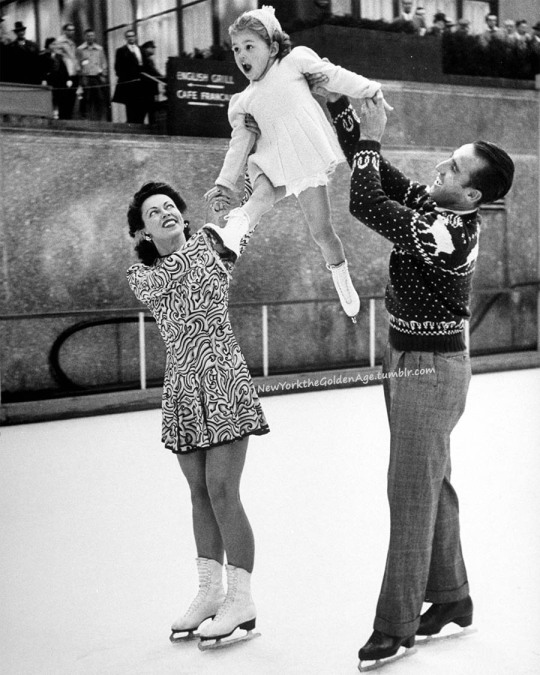
According to Life magazine, "Spectators who crowd the walls around Rockefeller Center's sunken skating rink are more easily moved by pratfalls than by pirouettes. Lately, however, this critical audience has been applauding the remarkable efforts of 3-year-old Helen Ann Rousselle." The image above ran in the story and shows Helen Ann flying through the air with the help of professional skaters Muriel Pack and Skippy Baxter. The photo was part of the cover story of the January 15, 1950 issue of Life.
Photo: George Silk via Life magazine Instagram
#vintage New York#1950s#George Silk#ice skating#Rockefeller Center rink#skating#skaters#Helen Ann Rousselle#Jan. 15#15 Jan.#Rockefeller Center#Life magazine#child skater#vintage NYC
52 notes
·
View notes
Text
And there shall be only one!
Pyrrha grimaced as she pulled her beloved Milo from the pool full of mud. She tried her best to shake and wipe the goop off her rifle, before taking her place at the firing line. She gave Jaune a look as he shot her his trademark smile.
Ren: LOAD!
Both had problems swapping magazines due to the mud, but Jaune was able to compensate faster than Pyrrha… but when it came to rack the action to load the first round…
Pyrrha: @$#%!
Everyone: (GASP)
Pyrrha: (Trying to work the action) MOTHER-@$#%&!
Thuds from spectators fainting could be heard.
Pyrrha: (Growling) Jaune…
--== Table of Contents ==--
31 notes
·
View notes
Text
by Phyllis Chesler
On Monday, a J Street and Democrat party operative posted a piece at her Substack. I am choosing not to name her or to link to the piece because I don’t want even more people to read it. The piece is titled in this way: “Elie Wiesel on indifference. A child killed in Gaza every 15 minutes. Two mothers every hour. Seven women every two hours. Are you OK with that?”
READ MORE: History Isn’t All Black and White. Just Look at Israel.
The piece then proceeds to trot out a series of mainly fake news talking points about the deaths of women and children in Gaza, hour by hour, day by day. How many J Streeters have expressed similar moral outrage about the much larger body counts in Ukraine (an estimated 30,457 civilians and 31,000 combatants, or 61,500 all together) and the Democratic Republic of the Congo (an estimated 5 to 6 million civilian deaths thus far)? We cannot trust the estimates of civilian and/or combatant deaths in Afghanistan, Pakistan, Syria, Iraq, China, North Korea, Sudan, Somalia, and so on.
To the best of my knowledge, few J Street–style journalists have presented the much larger body count in Ukraine and warned us against being indifferent to it — at least, not again and again, day after day.
The above-mentioned Substack piece is in gruesome lockstep with the New York Times, which, on the very same day, had five full pages of photos of murdered Gazans, all identified by age, name, and profession. In the paper’s pages, murdered Israelis rarely appear, nor do the many hundreds of thousands of displaced Israelis. They remain nameless and faceless, as do the Israeli hostages who’ve been hidden in Gaza for five months while they’ve been beaten, raped, tortured, starved, and murdered.
I sometimes wonder whether both the New York Times and J Street are on the Hamas/Iran payroll, whether they are simply funded by Soros — or whether they are true-believing Jew haters. One damning piece of evidence that they are Jew haters is their refusal to acknowledge Hamas’ complicity in civilian deaths. Hamas doesn’t just hide behind civilians when they are available; Hamas operates and maneuvers mostly in civilian areas, a clear violation of international law. Given this, and despite Israel’s almost suicidal efforts to prevent civilian deaths, J Street argues that Israel has no right to fight back against those trying to destroy them. (READ MORE from Phyllis Chesler: Silence of the Feminist Lambs: Not a Word on Hamas Horrors)
The piece up at Substack essentially dares to turn Elie Wiesel’s moral authority into a sock puppet in order to use his Holocaust-era perspective to condemn Israel and to warn us against our own “indifference” to Gazan civilian suffering. What Wiesel said, however, was far more relevant than the phrase quoted at Substack. Please allow me to quote from an interview given by him to Merle Hoffman in 1991, as reported in On the Issues magazine (full disclosure: I was the magazine’s editor at large at the time):
HOFFMAN: You have been severely criticized for not condemning Israel about the intifada. What is your current position on the Palestinian situation?
WIESEL: I have been criticized for many things… Yes, I refuse to systematically condemn Israel.
H: For anything?
W: There are certain red lines that I will not cross. If I had known at the time that Israel was involved in torturing I would have spoken out, but it was too late. When I found out, a commission had already been formed and justice prevailed, but I don’t feel I have the right to apply public pressure on Israel.
H: But you have the moral authority.
W: But what if I’m wrong?
H: Can’t you afford to be wrong?
W: Yes, but only if I pay the price. What if I am wrong and they pay the price? What if I apply such pressure on a decision and that decision may bring disaster or at least tragedy to Israel? Do I have the right to do this? It is their children who will pay the price, not mine. I do go to Israel and speak to the leaders there[.] I can say what I feel. But here, especially here, I have no right to speak out publicly…. I am offended when I see Jewish intellectuals who all of a sudden remember their Jewishness only to use that Jewishness to attack Israel. These are men and women who have never done anything for Israel [and] all of a sudden they remember they are Jews.
I hope and pray that J Streeters and Democratic Party operatives pay attention to these words of Weisel as well as to those they manipulate in order to condemn Israel.
14 notes
·
View notes